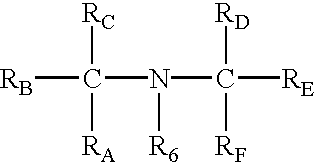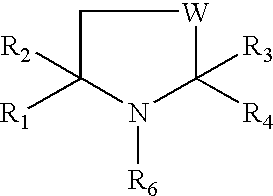Preparation for prevention and healing of inflammation affections
a technology for inflammation affections and preparations, applied in the field of preparation for prevention and healing of inflammation affections, can solve the problems of delayed healing process, tissue macromolecule degradation, and irreparable changes, and achieve the effect of protecting tissue and enhancing antibacterial
- Summary
- Abstract
- Description
- Claims
- Application Information
AI Technical Summary
Benefits of technology
Problems solved by technology
Method used
Image
Examples
example 1
A mixture of 80 g 2-hydroxyethyl methacrylate, 0.5 g N-(2,2,6,6-tetramethyl-piperdin-4-yl)methacrylamide, 0.6 g ethylene glycol dimethacrylate, 0.5 g 2,2'-azobis(2-methyl-propanenitrile) (AIBN) was heated in 1000 ml benzene at 70.degree. C. for a period of 12 hours. The formed polymer was extracted at room temperature with 1000 ml of benzene. The powdered polymer was agitated in a mixture water--poly(ethylene glycol) 300 (macrogolum 300), to obtain a gel of required consistency suitable for therapeutic applications.
example 2
A polymerization mixture prepared in accordance with Example 1 and after adding 0.08 g 2-dimethylaminoethyl methacrylate was polymerized in 1000 ml benzene at a temperature of 70.degree. C. for a period of 12 hours. The copolymer has been extracted with 1000 ml benzene and reacted with 10 ml of methyl iodide for 48 hours at room temperature and for another 2 days with 1000 ml benzene only. The obtained powdered polymer was dried.
example 3
The polymer prepared according to Example 1 was mixed with an aqueous 4% solution of copolymer poly[(2-hydroxyethyl methacrylate)-co-2-(methacryloyloxy)ethyl-trimethylammonium bromide] solution so that the concentration of the ammonium salt in the obtained polymer amounted 10.sup.-5 g / kg.
PUM
| Property | Measurement | Unit |
|---|---|---|
| temperature | aaaaa | aaaaa |
| water content | aaaaa | aaaaa |
| distance | aaaaa | aaaaa |
Abstract
Description
Claims
Application Information
 Login to View More
Login to View More - R&D
- Intellectual Property
- Life Sciences
- Materials
- Tech Scout
- Unparalleled Data Quality
- Higher Quality Content
- 60% Fewer Hallucinations
Browse by: Latest US Patents, China's latest patents, Technical Efficacy Thesaurus, Application Domain, Technology Topic, Popular Technical Reports.
© 2025 PatSnap. All rights reserved.Legal|Privacy policy|Modern Slavery Act Transparency Statement|Sitemap|About US| Contact US: help@patsnap.com



